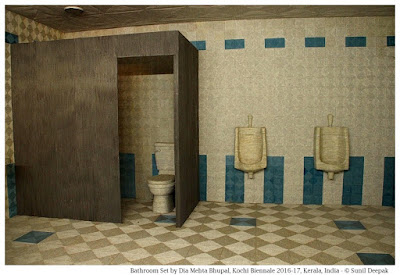Hinduism is based on the idea of all pervading universal consciousness known as Brahman, which has no beginning or end. Thus, mountains, trees, animals, birds and humans, everything animate or inanimate are the expression of Brahman and indicate a unity of all life forms.
In Hinduism, this idea of Brahman is coupled with Gods, one deity for each of the millions of life forms. In Theyyam, the dancer asks a God to come and become manifest in his body. Thus, during the dance-ritual, the dancer becomes an expression of God.
In other parts of India, there are persons who can go into trance and become "a channel of God" to speak and interact with people. For example, in north India they call it "Devi aayi hai" or the "Goddess has come". However, in Theyyam the invocation of God in human body is formalised and accompanied by specific costumes and rituals.
Theyyam is widespread in northern parts of Kerala state, especially around the town of Kannur. Each village and temple has its own Theyyam based a specific God or Goddess or local hero.
There are about 450 kinds of Theyyams. Each Theyyam has its own day during the year when its function will be organised in the village. Theyyam dancers are only men, usually from Hindu lower castes. Only one kind of Theyyam dancers are women.
Theyyam Preparation and Ritual
Around three weeks before the Theyyam celebration, the dancers start a period of abstinence to purify their bodies and minds. One day before Theyyam, they carry out a special invocation prayer called Thattam.
On the day of Theyyam, the dancer prepares his make-up using natural colours. During the make-up, their faces will carry complex designs for their specific Theyyam God and they will wear the ritual dress which is created and maintained by the dancer's family. The facial make-up for each Theyyam is also known as "Face-writing". The costumes include an elaborate head-dress and a breast-plate.
After completing the make-up and putting on the costume, the Theyyam dancer is shown his face in a mirror. This ritual is called Mukhadarshanam. It completes the arrival of God in his body. From that moment he ceases to be seen as human and becomes the manifestation of a specific God or Goddess.
Challenges Facing the Theyyam Traditions
Usually Theyyam dancers do it as a part of their family tradition and there is no or little income from it. With increasing modernisation, urbanisation and technology, it is becoming difficult for individuals to maintain complex social traditions like that of Theyyam, even if it has deep roots in the myths and cultures of the local societies.
Traditions like Theyyam are also under attack because some persons look at them as superstitions, or old fashioned backward rituals. They ignore its social roots and relevance, and look at it in isolation.
Theyyam plays a social role in the complex hierarchy of castes among Hindus. For example, in an interview, a Theyyam dancer said that though socially he belongs to a lower caste, when he becomes Theyyam, persons of all castes including Brahmins and upper caste persons must bend before him and ask for his blessing.
Theyyam Face Make-up in Kochi Folk-lore Museum
The Folk-lore Museum of Kochi has a collection of wooden heads illustrating the different "Face-Writing" designs made for different Gods and personas used in Theyyam. One of these is shown below.
Theyyam ritual dances are organised in villages in north Kerala during winter - especially between October to April. There is a weekly calendar of Theyyam events happening in different villages around the city of Kannur. You can find out it from different websites - here are two examples - TheyyamCalendar and KannurTravel.
Thus, if you want to observe a Theyyam ritual dance in its local village context, check the calendar and plan your visit to Kannur.
Conclusions
I have only seen Theyyam as a part of cultural programmes, as street art and as museum artifacts. I have used the images from those different encounters with Theyyam in this post. However, I hope one day to visit Kannur and see it as part of the local spiritual-religious tradition.
***
PS: In 2018, I had visited Kunoor and visited the sacred ceremonies of Theyyam in 2 villages. I was accompnaied by a local guide. It was an unforgettable experience, not just for the beautiful and exotic costmes and dances, but for its spirituality.































